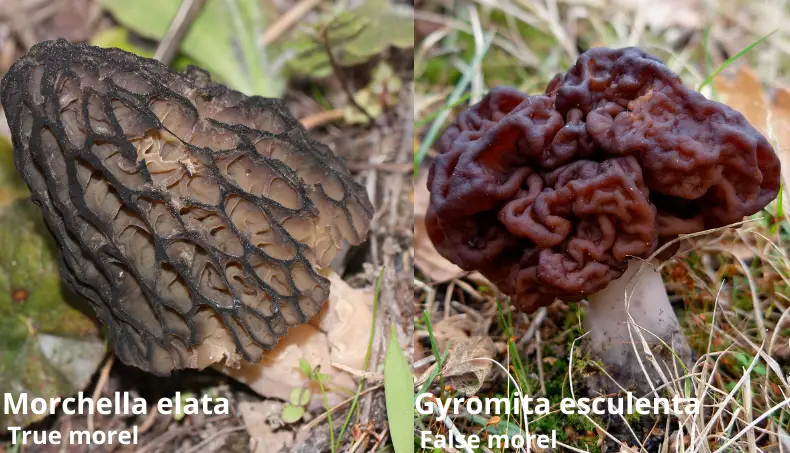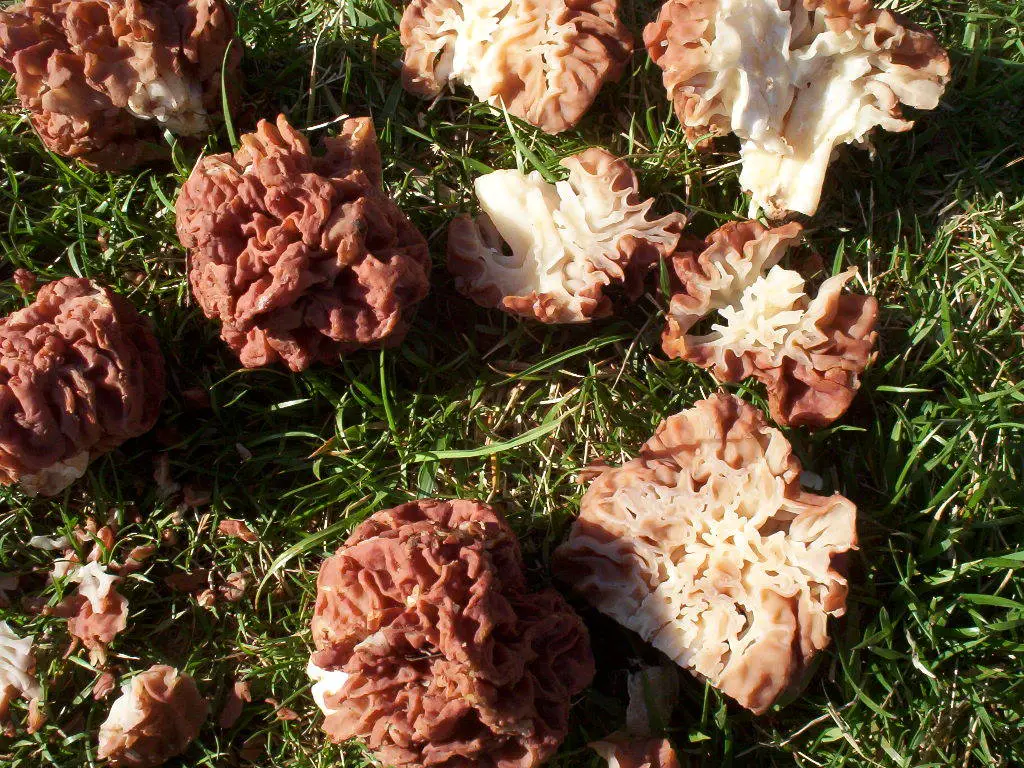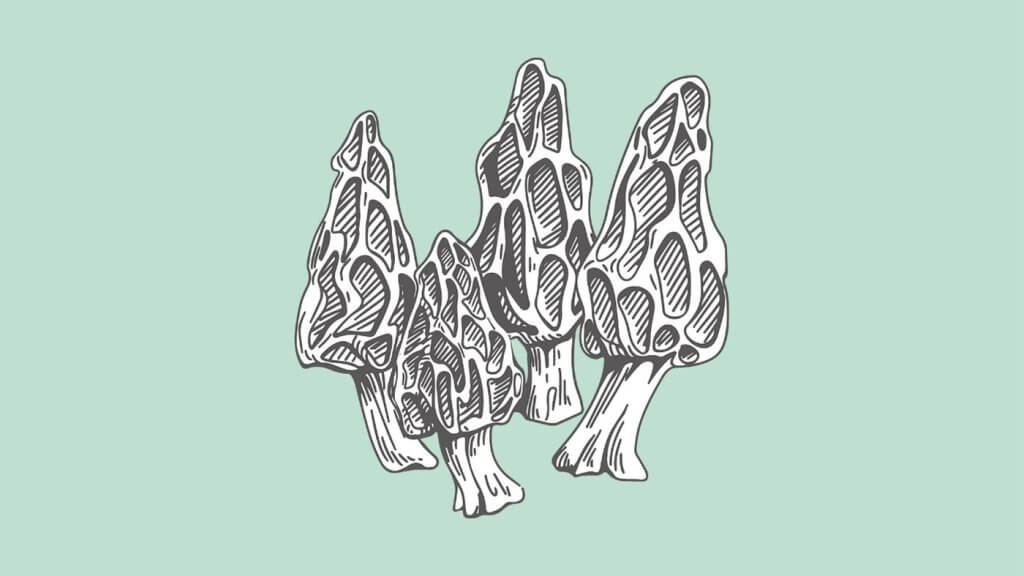While true morels have caps with pits angled towards the inside, a false morel's pits bulge outward. A false morel’s cap hangs freely; in most cases, a true morel’s cap is attached to the stem. A true morel is hollow inside. A false morel is filled with fiber-like tissue.
The true morel, known by its scientific name Morchella, comes from the Pezizales family. Within that family are several unrelated taxonomies of mushrooms: Helvella, Discinaceae, and Morchellaceae.
As a look-alike epithet to the true morel, the most well-known of this taxonomy, the false morel, belongs to members of the Gyromitra genus.
Difference Between a Morel and a False Morel
There are many look-alikes to the true morel mushroom. Because many of these look-alikes are poisonous, any mushroom hunter must know how to differentiate the two.
What Are You Foraging For Right Now?
We're thrilled to hear your ideas. What would you like to submit today? Feel free to share your thoughts and experiences with us.
Both true and false morel mushrooms grow in spring when the air and ground are still mild and moist.
The black morel, common morel, or yellow morel are often confused with the potentially dangerous false morel mushrooms.
Check the caps to know if you’re looking at false morel vs. morel mushrooms. The caps for true morels will be fully hollow and covered in pits that look like a honeycomb structure.
In contrast, the false morel will have an irregular and elaborate cap; hollow chambers and pits bulging towards the outside.
| Fungus | True morel | False morel |
| Cap | hollow, pits are turned inwards | irregular cap, pits bulging outwards |
| Cap attachment | often, cap attached to stem | cap hangs freely |
| Inside | hollow | cotton-like fiber inside |

Can you Eat a False Morel?
The morel mushroom, scientifically termed the Morchella, is a delicious wild and edible mushroom. In contrast, the false mushroom is inedible.
As a species of the Gyromitra, the poisonous false morel mushroom contains the toxin and carcinogen gyromitrin.
This toxin is unstable and quickly hydrolyzed into monomethylhydrazine. So, consuming gyromitrin can result in poisoning due to how it interferes with the central nervous system and the function of vitamin B6.
Eating enough false mushrooms can be highly toxic or even deadly, whether raw or cooked.
Remember to compare the cap to check for other false morels that are part of the Gyromitra species. Don’t leave out the Gyromitra esculenta (the beefsteak mushroom) and Gyromitra caroliniana.
Lastly, many consider the hooded false morel (Gyromitra infula) a highly deadly poisonous mushroom.
If you’re worried that you’ve eaten one of these inedible wild mushrooms like G.esculenta, you can look for signs of poisoning.
Some of these ill effects include:
- Nausea
- Stomach cramps
- Diarrhea
Severe poisoning can even lead to:
- Jaundice
- Convulsions
- Liver damage
- Kidney damage
- Coma
- Death (five days to a week after eating the fungi)
What’s more, monomethylhydrazine exposure appears to be carcinogenic in small mammals.

Are There Still Risks If You Cook False Morels?
Various species of false morel mushrooms are considered poisonous. Despite the toxicity of these gyromitra mushrooms, many still eat them globally because their natural toxicity levels change per location.
For example, foraging for false morels in elevated mountainous terrain has shown to be less toxic than those foraged in lowland pine forests.
If you’re keen to forage false morels, cooking is a helpful method to reduce toxicity. But remember, even well-cooked morels are not free of the dangers of toxicity.
Check our video on the 7 most poisonous mushrooms growing in the US (mushroom details and ingestion symptoms included)!
Where Do False Morels Grow?
Once you know the best type of year for your wild mushroom hunting, you need to know where to find them.
Mushroom hunters will be happy to know you can find morel mushrooms all over. In Europe and North America, you’ll find false morels about anywhere.
Morels are not so fussy when laying down their roots.
Watch our video to learn all about how to find, forage, and identify morel mushrooms!
Do False Morels Grow Near True Morels?
You often find poisonous false morel mushrooms growing next to each other in the same habitat. A fact that doesn’t exactly make it easier for mushroom hunters to distinguish between the two.
You may find a whole bunch or just a few false morels growing in a specific area and the same spot for several consecutive years.
But don’t expect to magically find your morels in the same location for the next year, as they can disappear.
False Morels: Any Benefits?
Despite their toxic nature, false morels have an incredible effect on the surrounding environment. False morels are mycorrhizal fungi because they form a symbiotic relationship with the trees around them.
In addition, many consider false morels to be saprotrophs because they feed on decaying and dead organic matter, helping clean up the forest floor.
Getting into the great, wet outdoors in search of edible plants, herbs, fruits and fungi is one of Sarah’s favorite outdoor pursuits. She thinks there’s nothing better than combining her passion for hiking with the start of the foraging season. Sarah’s definitely not afraid of a little rain and dirt, it’s all part of the fun.

